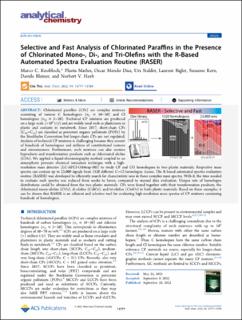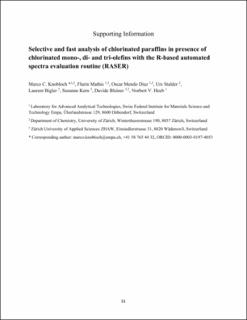Please use this identifier to cite or link to this item:
https://doi.org/10.21256/zhaw-26807Full metadata record
| DC Field | Value | Language |
|---|---|---|
| dc.contributor.author | Knobloch, Marco C. | - |
| dc.contributor.author | Mathis, Flurin | - |
| dc.contributor.author | Mendo Diaz, Oscar | - |
| dc.contributor.author | Stalder, Urs | - |
| dc.contributor.author | Bigler, Laurent | - |
| dc.contributor.author | Kern, Susanne | - |
| dc.contributor.author | Bleiner, Davide | - |
| dc.contributor.author | Heeb, Norbert V. | - |
| dc.date.accessioned | 2023-02-06T15:11:12Z | - |
| dc.date.available | 2023-02-06T15:11:12Z | - |
| dc.date.issued | 2022 | - |
| dc.identifier.issn | 0003-2700 | de_CH |
| dc.identifier.issn | 1520-6882 | de_CH |
| dc.identifier.uri | https://digitalcollection.zhaw.ch/handle/11475/26807 | - |
| dc.description.abstract | Chlorinated paraffins (CPs) are complex mixtures consisting of various C homologues (nC ≈ 10–30) and Cl homologues (nCl ≈ 2–20). Technical CP mixtures are produced on a large scale (>106 t/y) and are widely used such as plasticizers in plastic and coolants in metalwork. Since 2017, short-chain CPs (C10–C13) are classified as persistent organic pollutants (POPs) by the Stockholm Convention but longer-chain CPs are not regulated. Analysis of technical CP mixtures is challenging because they consist of hundreds of homologues and millions of constitutional isomers and stereoisomers. Furthermore, such mixtures can also contain byproducts and transformation products such as chlorinated olefins (COs). We applied a liquid-chromatography method coupled to an atmospheric pressure chemical ionization technique with a high-resolution mass detector (LC-APCI-Orbitrap-MS) to study CP and CO homologues in two plastic materials. Respective mass spectra can contain up to 23,000 signals from 1320 different C–Cl homologue classes. The R-based automated spectra evaluation routine (RASER) was developed to efficiently search for characteristic ions in these complex mass spectra. With it, the time needed to evaluate such spectra was reduced from weeks to hours, compared to manual data evaluation. Unique sets of homologue distributions could be obtained from the two plastic materials. CPs were found together with their transformation products, the chlorinated mono-olefins (COs), di-olefins (CdiOs), and tri-olefins (CtriOs) in both plastic materials. Based on these examples, it can be shown that RASER is an efficient and selective tool for evaluating high-resolution mass spectra of CP mixtures containing hundreds of homologues. | de_CH |
| dc.language.iso | en | de_CH |
| dc.publisher | American Chemical Society | de_CH |
| dc.relation.ispartof | Analytical Chemistry | de_CH |
| dc.rights | Licence according to publishing contract | de_CH |
| dc.subject | Carbon | de_CH |
| dc.subject | Cluster chemistry | de_CH |
| dc.subject | Isotopes | de_CH |
| dc.subject | Materials | de_CH |
| dc.subject | Plastics | de_CH |
| dc.subject.ddc | 540: Chemie | de_CH |
| dc.title | Selective and fast analysis of chlorinated paraffins in the presence of chlorinated mono-, di-, and tri-olefins with the R-based automated spectra evaluation routine (RASER) | de_CH |
| dc.type | Beitrag in wissenschaftlicher Zeitschrift | de_CH |
| dcterms.type | Text | de_CH |
| zhaw.departement | Life Sciences und Facility Management | de_CH |
| zhaw.organisationalunit | Institut für Chemie und Biotechnologie (ICBT) | de_CH |
| dc.identifier.doi | 10.1021/acs.analchem.2c02240 | de_CH |
| dc.identifier.doi | 10.21256/zhaw-26807 | - |
| zhaw.funding.eu | No | de_CH |
| zhaw.issue | 94 | de_CH |
| zhaw.originated.zhaw | Yes | de_CH |
| zhaw.pages.end | 13784 | de_CH |
| zhaw.pages.start | 13777 | de_CH |
| zhaw.publication.status | publishedVersion | de_CH |
| zhaw.embargo.end | 2023-09-28 | de_CH |
| zhaw.publication.review | Peer review (Publikation) | de_CH |
| zhaw.author.additional | No | de_CH |
| zhaw.display.portrait | No | de_CH |
| Appears in collections: | Publikationen Life Sciences und Facility Management | |
Files in This Item:
| File | Description | Size | Format | |
|---|---|---|---|---|
| 2022_Knobloch-etal_Selective-fast-analysis-chlorinated-paraffins_Artikel_acs.analchem.pdf | Article | 4.25 MB | Adobe PDF |  View/Open |
| 2022_Knobloch-etal_Selective-fast-analysis-chlorinated-paraffins_Supplement_acs.analchem.pdf | Supporting Information | 1.82 MB | Adobe PDF |  View/Open |
Show simple item record
Knobloch, M. C., Mathis, F., Mendo Diaz, O., Stalder, U., Bigler, L., Kern, S., Bleiner, D., & Heeb, N. V. (2022). Selective and fast analysis of chlorinated paraffins in the presence of chlorinated mono-, di-, and tri-olefins with the R-based automated spectra evaluation routine (RASER). Analytical Chemistry, 94, 13777–13784. https://doi.org/10.1021/acs.analchem.2c02240
Knobloch, M.C. et al. (2022) ‘Selective and fast analysis of chlorinated paraffins in the presence of chlorinated mono-, di-, and tri-olefins with the R-based automated spectra evaluation routine (RASER)’, Analytical Chemistry, (94), pp. 13777–13784. Available at: https://doi.org/10.1021/acs.analchem.2c02240.
M. C. Knobloch et al., “Selective and fast analysis of chlorinated paraffins in the presence of chlorinated mono-, di-, and tri-olefins with the R-based automated spectra evaluation routine (RASER),” Analytical Chemistry, no. 94, pp. 13777–13784, 2022, doi: 10.1021/acs.analchem.2c02240.
KNOBLOCH, Marco C., Flurin MATHIS, Oscar MENDO DIAZ, Urs STALDER, Laurent BIGLER, Susanne KERN, Davide BLEINER und Norbert V. HEEB, 2022. Selective and fast analysis of chlorinated paraffins in the presence of chlorinated mono-, di-, and tri-olefins with the R-based automated spectra evaluation routine (RASER). Analytical Chemistry. 2022. Nr. 94, S. 13777–13784. DOI 10.1021/acs.analchem.2c02240
Knobloch, Marco C., Flurin Mathis, Oscar Mendo Diaz, Urs Stalder, Laurent Bigler, Susanne Kern, Davide Bleiner, and Norbert V. Heeb. 2022. “Selective and Fast Analysis of Chlorinated Paraffins in the Presence of Chlorinated Mono-, Di-, and Tri-Olefins with the R-Based Automated Spectra Evaluation Routine (RASER).” Analytical Chemistry, no. 94: 13777–84. https://doi.org/10.1021/acs.analchem.2c02240.
Knobloch, Marco C., et al. “Selective and Fast Analysis of Chlorinated Paraffins in the Presence of Chlorinated Mono-, Di-, and Tri-Olefins with the R-Based Automated Spectra Evaluation Routine (RASER).” Analytical Chemistry, no. 94, 2022, pp. 13777–84, https://doi.org/10.1021/acs.analchem.2c02240.
Items in DSpace are protected by copyright, with all rights reserved, unless otherwise indicated.